Veteran’s Testimony – Eugene J. Glazer Hospital Train No. 13 / Hospital Train No. 7
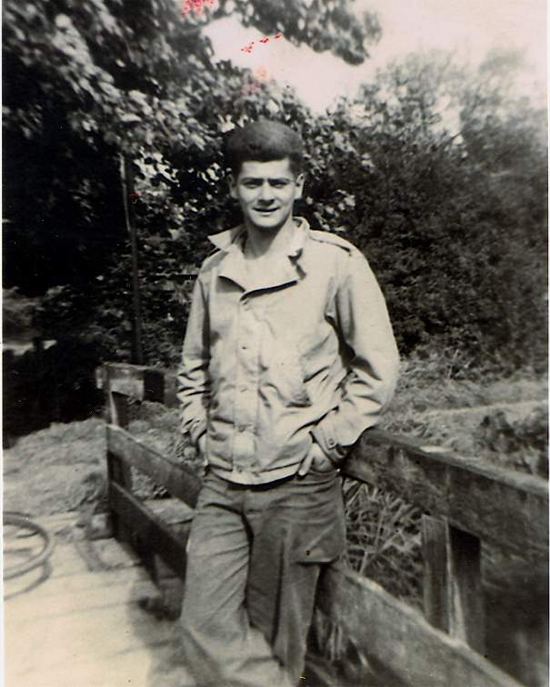
Private Eugene J. Glazer, ASN 32935607, during one his many trips through France.
Introduction:
I am a native of New York, where I was born in 1924. We lived in Liberty, New York. After 4 years of High School, I received my orders to report for induction, got duly registered, and was finally inducted in Binghamton County, New York on 22 April 1943. After spending 2 more days at a large camp on Long Island (can’t recall its name), I was sent, together with another group of recently inducted young men to Cp. Pickett, Blackstone, Virginia (Division Camp, acreage 45,867 troop capacity 2,363 Officers and 41,552 EM). Cp. Pickett was activated 19 June 1942 (it operated until 31 October 1943) and comprised 14 Medical Training Battalions. It was part of the first four Medical Replacement Training Centers (MRTC), including Cp. Barkeley (Texas), Cp. Grant (Illinois), and Cp. J. T. Robinson (Arkansas).
Training:
The Training for Medical (MOS 123) and Surgical Technicians (MOS 225) was mostly organized as a single program; trainees would thus attend classes together during the first month or two, and were then separated during the final on-the-job instruction phase of the program. At that point, such as in my case, we were assigned to Medical wards. At first, the course duration was only 2 months, but since proven inadequate (too little time for practice), it was extended to 3 months. The general program for Medical Technicians consisted of 12 weeks of intensive training designed to prepare soldiers for service with all types of medical units and installations. Lectures and demos were most common during the initial period (first month), when as trainees we were introduced to fundamentals, then instruction was to focus on anatomy, physiology, hygiene, sanitation, disease prevention, ward procedure, and management and emergency medical treatment. Later on (second month), training centered on first-aid and emergency care of injuries and diseases common to war medicine, with topics such as inflammation and infection of wounds, burns, gas casualties, and injuries to the various regions of the human body. The last period was exclusively devoted to ward operation and technique, and the trainees then spent some time working in Hospital wards, learning the various duties of a ward attendant, under supervision of a qualified Nurse.
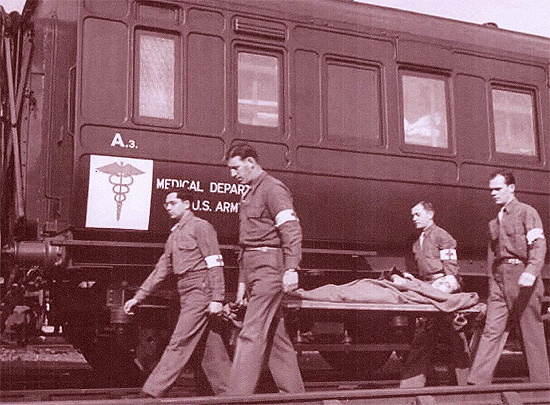
Somewhere in London, 1944. Litter bearers carry a patient to one of the ward cars of Hospital Train No. 16.
Training Program (illustrating some of the major medical subjects)
| Elementary Anatomy and Physiology | 21 hours |
| Treatment of Gas Casualties | 8 hours |
| Field Sanitation and Sanitary Appliances | 20 hours |
| Medical Pharmacy | 12 hours |
| Medical and Surgical Nursing | 16 hours |
| Medical Aids (Splints, Bandages, Dressings) | 60 hours |
The Training Program I received was based on MTP No. 8-5 (introduced 2 January 1942). This (modified) Mobilization Training Program included a training cycle shortened to 8 weeks and a technical training portion of 4 weeks only. At the end of the program, I was sent to Lawson General Hospital, Atlanta, Georgia (designated a US Army General Hospital by WD Directive – Ltr. AG 322.3 dated 9 Jan 41 – the installation was a wooden cantonment with an authorized bed capacity for 2,514 patients which opened on 22 July 1941 –ed) for practical training as a Medical Technician. I was later transferred to Ft. McPherson, Atlanta, Georgia (Reception & Reclassification Center, acreage 371, troop capacity 335 Officers and 5,917 Enlisted Men –ed), where our outfit was to be activated. Later we were sent to Cp. Forrest, Tullahoma, Tennessee (Infantry Division Camp, acreage 73,124 troop capacity 1,886 Officers and 32,368 EM –ed) where we participated in a run with our ‘first’ Hospital Train.
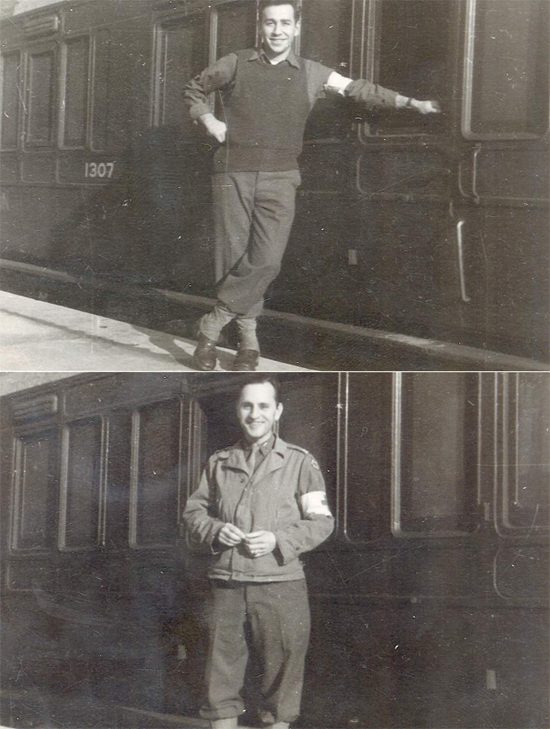
Picture of Pvt. Gene J. Glazer standing in front of one of the hospital ward cars, Hospital Train No. 13.
Evacuation by Hospital Trains:
A total of 8 Hospital Train units, specially destined for overseas Theaters were organized between June 1942 – June 1943.
The means of transporting sick and wounded from Evacuation Hospitals in the combat zone to a Hospital in the Communications Zone (designated Primary Evacuation) consisted of:
Hospital Trains
Trains for Patients
Hospital Ships
Motor Convoys
Airplane Ambulances
During World War 2 the usual method of transporting patients from the Evacuation Hospitals to General Hospitals in ComZ was by means of Hospital Trains. Hospital Trains were in fact true Medical Department organizations; their distribution and use was controlled by the Medical Department. Personnel, supply, and maintenance of the medical equipment was handled and controlled by The Chief Surgeon of the Communications Zone (under Theater control) while the Trains were operated and maintained mechanically under the direction of the Corps of Engineers. Hospital Train Maintenance Platoons (5 Off & 135 EM) were activated and transferred to the Transportation Corps, while overseas or en route for overseas.
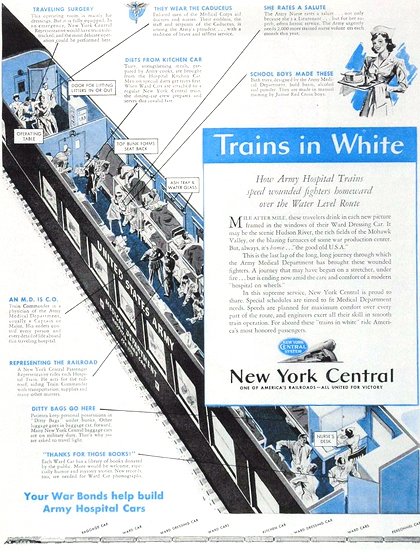
1944 Advertisement (on Army Hospital Trains) run in some stateside Magazines, appealing to the population to support the War effort by subscribing to War Bonds.
Evacuation within the Communications Zone (ComZ): in addition to the trains specifically assigned to Regulating Stations, a number of Hospital Trains were placed by G-4 (Supply & Evacuation Officer, Headquarters), directly under control of the CG, ComZ, and held at suitable places designated by the latter. These trains were thus utilized for “Communications Zone” evacuation. All train movements were coordinated by G-4 on recommendations of The Chief Surgeon, ComZ. There existed an agreement that The Surgeon, ComZ, could directly call the Director of Transportation for any movement relating to the movement of Hospital Trains as desired by the Medical Department.
Overseas Movement – United Kingdom:
We were activated August-September 1943 at Ft. McPherson, Georgia. After staging at New York P/E, we finally left for overseas course of February 1944, landing at Cardiff, Wales, the last week of February. Our first home was a tent city, called Camp Pinkney Park, Sherston, Wiltshire, England. We then got transferred to a place called Newbury, in Berkshire, England (where were received our first train in April or May 1944 and which became our home base in the British Isles). My outfit, Hospital Train No. 13 was a converted British passenger train, refurbished and modified to transport patients and medical staff. It would operate in the European Theater from February 1944 onward, and also travel in England, France, Belgium, and Germany. Before D-Day, and in order to prepare for and expand the evacuation process for patients received from the various Theaters of Operations, the US Medical Department Evacuation Branch employed 15 British-built and operated and US Army-staffed Hospital Trains (with a 300-patient capacity) based in south-western England. On 7 June 1944, we were on standby at Southampton, waiting to receive the first wave of casualties from the D-Day invasion, which was going to be our first real test at doing the tasks we were trained for. It became a traumatic experience for all of us and the first awareness that there was a horrible war taking place not far away from us, and discovering that we were very much part of it! After D-Day, the Medical Corps and the Transportation Corps joined efforts to put more Hospital Trains in service, and subsequently moved 17 Hospital Trains across the Channel to Cherbourg. To supplement the effort and because of additional requirements, 3 extra trains were improvised from French hospital and passenger cars outfitted with American and captured German medical stocks.
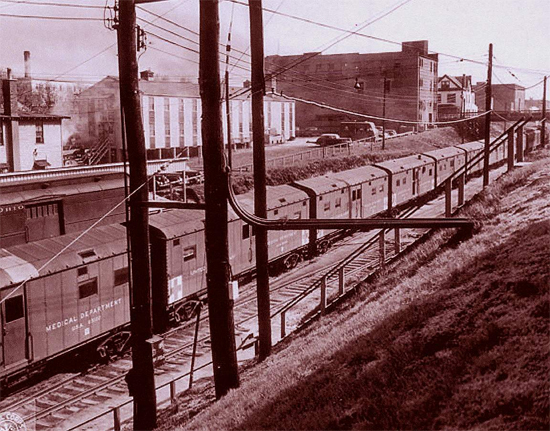
Hospital Cars waiting to pick up patients at the Chesapeake and Ohio Depot, Newport News, Virginia. Picture taken 14 April 1944.
Location of Hospital Trains in the British Isles
Hospital Train No. 13 – Moreton-in-Marsh (Gloucestershire) 21 May 44 > 24 May 44
Hospital Train No. 13 – Milford Haven (Wales) 24 May 44 > 3 November 44
Hospital Train No. 13 – Andover (Hampshire) 21 June 45 > 10 September 45 (inactivated)
Hospital Train No. 7 – Newbury (Berkshire) 3 June 43 > 23 June 43
Hospital Train No. 7 – Malmesbury (Wiltshire) 7 March 44 > 12 March 44
Hospital Train No. 7 – Tetbury (Gloucestershire) 12 March 44 > 21 April 44
From then on, Hospital Train No. 13 transported a lot of wounded throughout Britain to places such as Birmingham, Bristol, Cardiff, Malvern, Manchester, Newbury, Reading, Swindon, etc.
European Continent – France:
Prior to leaving England, we changed to a new designation, Hospital Train No. 7, or was it shortly after reaching the continent? We crossed over to France in August 1944 (having had to wait for a new train, as the first one was a total loss caused by an accidental fire late at night, in July), arriving by way of a British Car Ferry landing at Cherbourg; by the way, our unit was the first Hospital Train to reach Paris (Gare St. Lazare) on 2 September 1944! The Gare St. Lazare (Paris, France) became our home base as it also held a medical supply point and rest and bathing facilities for the hard working staffs, later followed by the Gare de l’Est, some time early February of 1945, with short interim periods at Commercy, France. Starting from this center point we covered thousands of miles and attended to numerous wounded. We often picked up patients at an Evacuation Hospital, attended to them, and dropped them off at a General Hospital; at times we would go back to another Evacuation Hospital and continue on for 2 or 3 weeks before returning to Paris. The procedure was to take the train as close as possible, usually an Evacuation Hospital to pick up patients, attend to them as best as we could, and get them back to the rear and to a larger, better equipped Hospital in France.
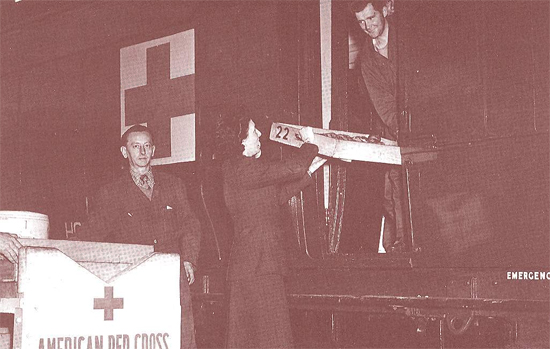
Somewhere in the European Theater (France or Belgium), en route for evacuation. American Red Cross workers supply donuts for casualties of a Hospital Train.
Evacuation by Hospital Trains (ADSEC, ComZ data)
| August 44 | 1,282 patients |
| September 44 | 5,174 patients |
| October 44 | 27,393 patients |
After its liberation, Paris rapidly became the hub of the continental evacuation system, with major rail lines from Belgium and eastern France converging at the French Capital. The town not only had a large concentration of General Hospitals, but moreover two major airports, Le Bourget and Orly, for further possible air evacuation to Britain and or the Zone of Interior. With more Hospital Trains based in Paris, the 552d Motor Ambulance Company went into operation for transferring patients between railway stations and General Hospitals.
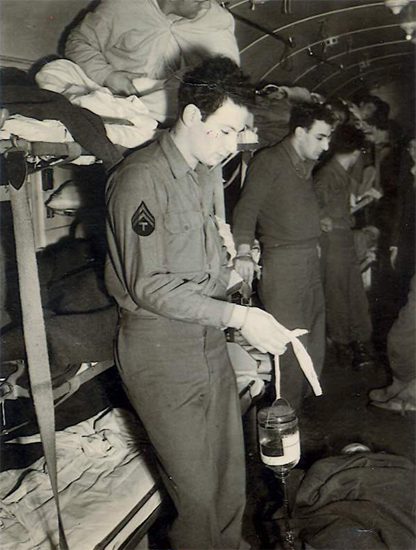
Picture of medical personnel on board Hospital Train No. 7. Picture shot by Gene J. Glazer while traveling through France.
Our Detachment consisted of 4 Doctors, 3 Nurses, and a complement of 15 to 20 medical personnel headed by a First Sergeant (the official T/O 8-420 dated 1 April 1942, indicated an aggregate of 4 Commissioned Officers – 6 Nurses – 33 Enlisted Men).
Officers & Senior NCO Personnel List (incomplete)
| Major Clarence Pritchard | CO 13th Hospital Train |
| Captain Levine | |
| Captain Hefner | |
| First Lieutenant Blackburn | |
| First Sergeant Joseph Walters |
In France, the Hospital Train No. 7 crisscrossed the country increasing its mileage; I remember place names such as Avranches, Caen, Cherbourg, Dijon, Metz, Mourmelon, St.-Lô and Ste-Mère-Eglise; in Belgium we visited Liège and Verviers; in Germany we were often in Aachen, Augsburg, Hamburg, Munich, and Stuttgart. We usually had an average of 36 patients to a car – 2 of us attended them during day, and then we alternated 4 hour-shifts … Sometimes a number of the wounded were so bad that the Major (our CO) often called ahead so that we could deliver them to a Hospital much nearer than the one planned. If not, we would have lost too many!
Moving through Europe – Belgium:
In the latter part of 1944 and the start of 1945, we were again on hand to take out the first groups of wounded from the Battle of the Bulge. As soon as Allied Forces broke through our train was despatched to pick up many of the first wave of casualties from a Field or Evacuation Hospital. I believe that a great number of evacuees were severe frostbite cases. My most vivid recollection of that period remains the stench of war; the smell of gangrene was overwhelming! The greatest fear among those brave doughboys was expressed when they would ask me: “will my leg (or arm, hand, or foot) have to come off?”. Of the thousands of patients I treated, one stands out and forever remains in my memory. He survived the Battle of the Bulge, was 21-23 years old, over 6 foot tall and built like a middle linebacker in the NFL; we only spoke for a few minutes, I lied about his leg (which was already eaten away by gangrene) and gave him a heavy shot of morphine. I will never be able to erase this memory. That one incident with this G.I. seemed to sum up for me the whole insanity of war!
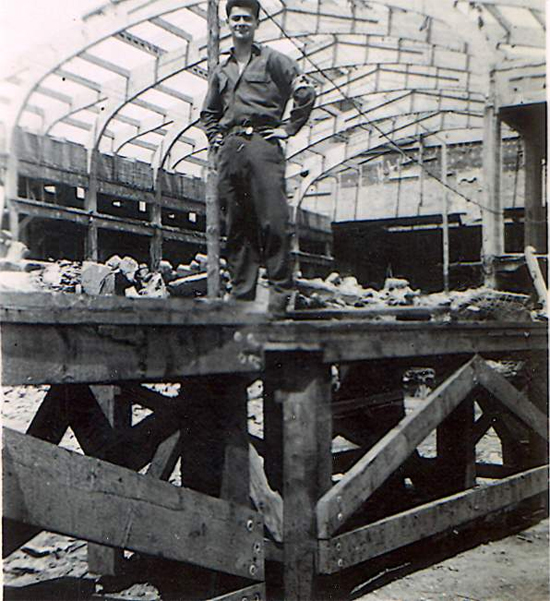
Gene J. Glazer standing on a bombed platform (railhead in France or Belgium) after a Luftwaffe air raid or a V-1 impact.
Whatever harm or damage could be done to the human body, we dealt with it on a daily basis! The trains ran on a tight schedule, and sometimes we were held up by overcrowded rail lines, lack of rolling stock, or we had to wait for bombed rails to be repaired, or seek refuge from Hitler’s buzz bombs or long range artillery which did not differentiate between us and regular combat troops. All this attested that while on the continent, we were often in a combat zone, but we attended to the casualties’ wounds and dealt with easing their pain as best as we could … We therefore received the ETO Campaign ribbon (European-African-Middle Eastern Campaign) and one miniature Bronze Service Star for our constant presence in active combat zones.
The MRC staff are indebted to Pfc Gene J. Glazer (ASN: 32935607), a trained Medical Technician who served with Hospital Train No. 7 in the European Theater during World War 2. The role of the Hospital Trains is often forgotten, yet the medical personnel who were involved in this particular process of evacuation from the combat zone, were equally dealing with pain, suffering, and the stench of war, on a daily basis. We’re still looking for any additional data and a complete roster that might help us finalize the unit’s service in the European Theater.
